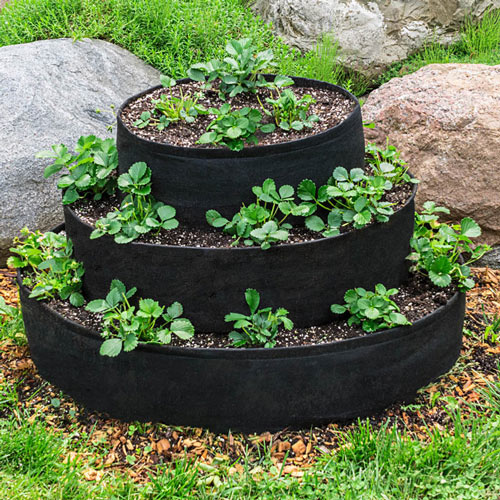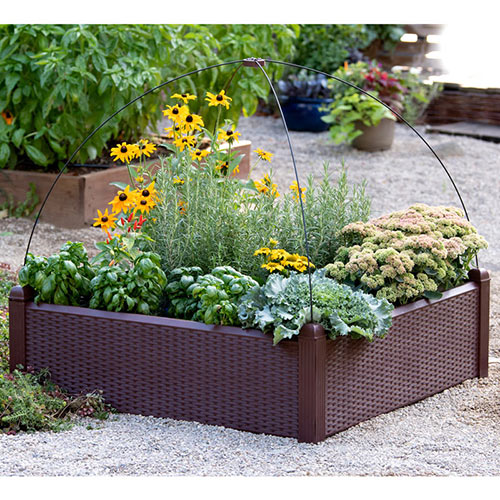Hügelkultur & Raised Bed Building
-
Helpful Products from Gardens Alive!
-
 Grow Tub® Tiered Strawberry Planter
Grow Tub® Tiered Strawberry Planter -
 A La Carte Mobile Garden
A La Carte Mobile Garden -
 Simple Solution Raised Bed
Simple Solution Raised Bed
Q. Marsha in Raphine, Virginia has a lot of questions; all of which are perfect for this time of year. She writes: "I am thinking of building at least one raised bed for vegetables this year. My site is not level so the bed will need to be 12-18 inches deeper on one side than the other. I have some decaying wood chips on site; could I use these as "fill" for the deep side of the raised bed?"
A. Yes; in fact, you'd be practicing a form of hügelkultur when you do it! An offshoot of Permaculture, the classic form of hügelkultur involves piling up big chunks of wood like tree stumps and covering them with soil to create a permanent planting 'mound' for new trees and such. The theory is that the wood will slowly degrade over time, releasing its nutrients as it does.
I could never wrap my head around this 'big mound' style of planting, but I recently came up with a way to use the basic concept in one of my newest projects: A big rectangular container containing three large squarish containers that I'm using to replace an ancient, falling apart half whiskey barrel on my patio that only looked appropriate at Halloween, when we 'planted' skeleton hands in it.
"We" (meaning my new intern Sean) were emptying the soil out of the thing that was once a half barrel when he asked what we should do with the rotting staves. Then it hit me! (No, not the staves and not Sean!) The new containers are deeper than I need, and I wanted to make sure there was good drainage in the system, so I decided to put the rotting wood staves in the bottoms before we filled them up. Unlike stones, broken flowerpot shards and other nonsense, the wood will slowly release nutrients to the soil. Holy hügelkultur Bat Fans!
Marsha continues: "Do you have any recommendations for the material to use in framing the bed?"
You can use just about anything EXCEPT old railroad ties or pressure treated wood. Naturally rot-resistant cedar landscape timbers are a popular choice; and metal frames are the good-looking new kids on the block. There are composite materials like Trex, which looks like lumber but is made of half recycled wood scraps and half recycled plastic, which is what my beds are framed with. The boards will last forever, and I really like the idea of buying the end stage result of recycling--especially keeping the plastic component out of our oceans and landfills. And many people just buy untreated pine landscape timbers, which like my rotting staves, will eventually become soil.
Back to Marsha: "What type of soil is best to use to fill the bed?"
A. NOT garden soil! As tempting as this option might be, garden soil is loaded with weed seeds, insect eggs and potential pathogens. Now--if you have a VERY deep container to fill, you can use garden soil to fill the bottom; as long as you save the top two feet for your garden mix. Or, better yet, use branches and arborist wood chips in the bottom. Then you can cut the topping to around 18 inches.
I've been recommending the same raised bed and container mix for decades and see no reason to stray: finished compost, screened topsoil and a big bag of perlite mixed into every 4 by 8 bed.
FINISHED compost should look like good soil, smell like good soil and squeeze like good soil; look for it in bulk near you and then start making your own in the Fall.
Topsoil: You want screened topsoil, which should have few to no clumps. It also should be nice and dark when dry and have no off-smells.
Perlite is a mined volcanic mineral that's 'popped' in big ovens, creating lots of tiny spaces inside the tiny popped rocks. These crevices will both hold water and improve drainage, which is a nifty trick. Buy a huge bag (which will weigh around three or four pounds); you can never have too much perlite. Note: Vermiculite is NOT the same; stick with perlite.
And finally, Marsha asks: "What's the best way to protect the bed from deer? I am starting small with the idea of expanding to multiple raised beds in future years. This will be a joint project with my disabled son and I have not yet decided what to plant."
Two products I highly recommend:
• Motion-activated sprinklers. Hook them up to a hose, aim them at your garden and they will toss cold water at whatever is moving too close to the string beans. And yes, you WILL get nailed when you forget it's on; not the worst thing that can happen on a hot summer day.
• The Wireless Deer Fence. A short plastic stake that you 'prime' by attaching a scent pellet that attracts deer to the top of the device. Then you install batteries in its bulging belly. Deer will be attracted to the scent pellet, attempt to lick it and get a mild shock from the electrodes on the top. The theory is that they'll remember this, associate it with your garden and run off to eat someone else's salad greens, now and in the future. Sold in sets of three with scent pellets by the creator at wireless deer fence dot com.
A. Yes; in fact, you'd be practicing a form of hügelkultur when you do it! An offshoot of Permaculture, the classic form of hügelkultur involves piling up big chunks of wood like tree stumps and covering them with soil to create a permanent planting 'mound' for new trees and such. The theory is that the wood will slowly degrade over time, releasing its nutrients as it does.
I could never wrap my head around this 'big mound' style of planting, but I recently came up with a way to use the basic concept in one of my newest projects: A big rectangular container containing three large squarish containers that I'm using to replace an ancient, falling apart half whiskey barrel on my patio that only looked appropriate at Halloween, when we 'planted' skeleton hands in it.
"We" (meaning my new intern Sean) were emptying the soil out of the thing that was once a half barrel when he asked what we should do with the rotting staves. Then it hit me! (No, not the staves and not Sean!) The new containers are deeper than I need, and I wanted to make sure there was good drainage in the system, so I decided to put the rotting wood staves in the bottoms before we filled them up. Unlike stones, broken flowerpot shards and other nonsense, the wood will slowly release nutrients to the soil. Holy hügelkultur Bat Fans!
Marsha continues: "Do you have any recommendations for the material to use in framing the bed?"
You can use just about anything EXCEPT old railroad ties or pressure treated wood. Naturally rot-resistant cedar landscape timbers are a popular choice; and metal frames are the good-looking new kids on the block. There are composite materials like Trex, which looks like lumber but is made of half recycled wood scraps and half recycled plastic, which is what my beds are framed with. The boards will last forever, and I really like the idea of buying the end stage result of recycling--especially keeping the plastic component out of our oceans and landfills. And many people just buy untreated pine landscape timbers, which like my rotting staves, will eventually become soil.
Back to Marsha: "What type of soil is best to use to fill the bed?"
A. NOT garden soil! As tempting as this option might be, garden soil is loaded with weed seeds, insect eggs and potential pathogens. Now--if you have a VERY deep container to fill, you can use garden soil to fill the bottom; as long as you save the top two feet for your garden mix. Or, better yet, use branches and arborist wood chips in the bottom. Then you can cut the topping to around 18 inches.
I've been recommending the same raised bed and container mix for decades and see no reason to stray: finished compost, screened topsoil and a big bag of perlite mixed into every 4 by 8 bed.
FINISHED compost should look like good soil, smell like good soil and squeeze like good soil; look for it in bulk near you and then start making your own in the Fall.
Topsoil: You want screened topsoil, which should have few to no clumps. It also should be nice and dark when dry and have no off-smells.
Perlite is a mined volcanic mineral that's 'popped' in big ovens, creating lots of tiny spaces inside the tiny popped rocks. These crevices will both hold water and improve drainage, which is a nifty trick. Buy a huge bag (which will weigh around three or four pounds); you can never have too much perlite. Note: Vermiculite is NOT the same; stick with perlite.
And finally, Marsha asks: "What's the best way to protect the bed from deer? I am starting small with the idea of expanding to multiple raised beds in future years. This will be a joint project with my disabled son and I have not yet decided what to plant."
Two products I highly recommend:
• Motion-activated sprinklers. Hook them up to a hose, aim them at your garden and they will toss cold water at whatever is moving too close to the string beans. And yes, you WILL get nailed when you forget it's on; not the worst thing that can happen on a hot summer day.
• The Wireless Deer Fence. A short plastic stake that you 'prime' by attaching a scent pellet that attracts deer to the top of the device. Then you install batteries in its bulging belly. Deer will be attracted to the scent pellet, attempt to lick it and get a mild shock from the electrodes on the top. The theory is that they'll remember this, associate it with your garden and run off to eat someone else's salad greens, now and in the future. Sold in sets of three with scent pellets by the creator at wireless deer fence dot com.
-
Helpful Products from Gardens Alive!
-
 Grow Tub® Tiered Strawberry Planter
Grow Tub® Tiered Strawberry Planter -
 A La Carte Mobile Garden
A La Carte Mobile Garden -
 Simple Solution Raised Bed
Simple Solution Raised Bed







 Gardens Alive! & Supplies
Gardens Alive! & Supplies




